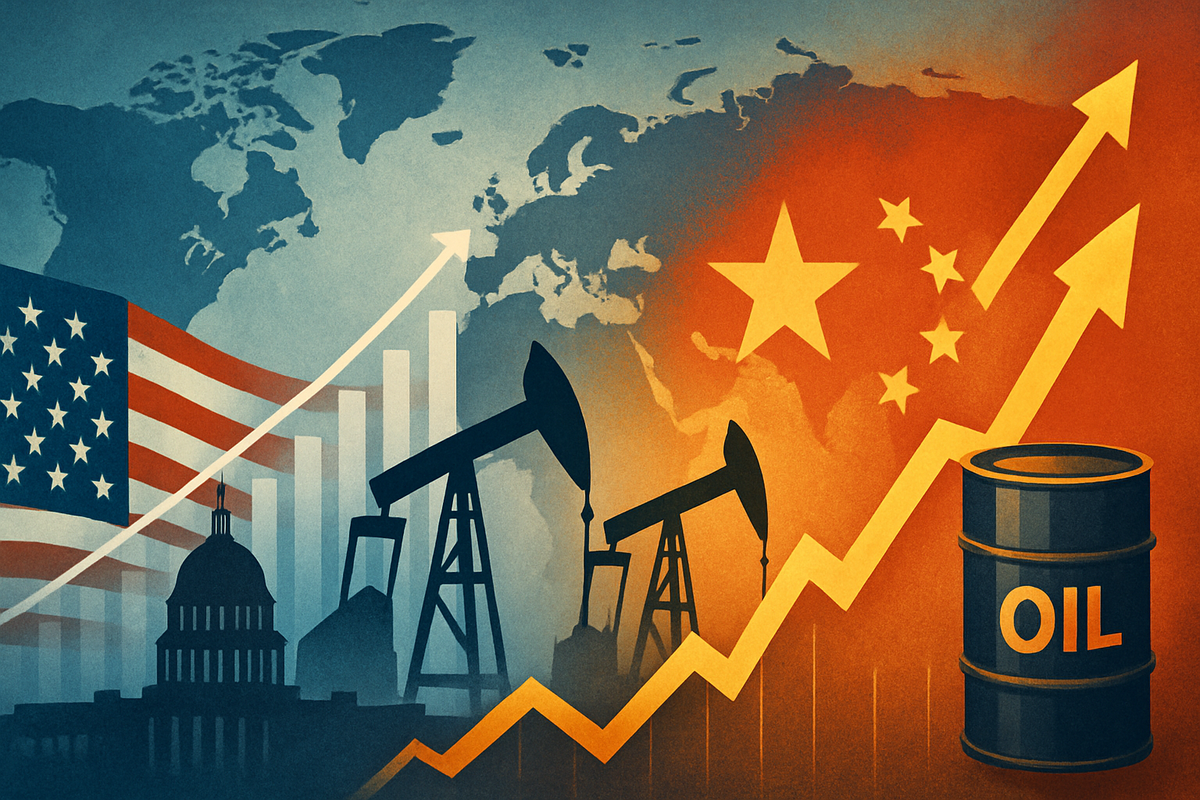
Global financial markets are experiencing a complex and volatile day, marked by a significant 5% surge in oil prices following new, stringent U.S. and EU sanctions on major Russian oil companies. This dramatic move in the energy sector is driving a notable rally in energy stocks and contributing to overall market gains, even as broader investor sentiment remains carefully poised amidst fluctuating U.S.-China trade relations. While initial hopes for easing tensions between the world's two largest economies have provided some uplift, the underlying reality on October 23, 2025, is one of ongoing escalation, tempered by the anticipation of crucial de-escalation talks.
The immediate implications are multifaceted: energy companies are basking in renewed investor confidence, pushing major indices higher, while the sudden spike in crude costs is simultaneously reigniting inflation concerns. This delicate balance of geopolitical maneuvers and commodity market dynamics is creating a landscape where opportunities and risks are emerging with equal intensity, forcing investors to recalibrate their strategies in real-time.
Geopolitical Tensions Reshape Market Dynamics
Today's market movements are a direct consequence of two potent geopolitical forces. Firstly, the U.S., in a coordinated effort with the European Union, announced a fresh round of sanctions targeting Russia's two largest oil producers, Rosneft and Lukoil. This aggressive measure, implemented in response to the ongoing conflict in Ukraine, immediately sent shockwaves through the global oil market. Brent crude futures jumped by 5.4% to 5.7%, settling around $66 per barrel, while West Texas Intermediate (WTI) crude futures saw a comparable rise of 5.2% to 5.6%, climbing above $61 per barrel. This marks the largest single-day leap for Brent crude since mid-June, reflecting acute market concerns over tightening global supply as major buyers, particularly in Asia, reportedly prepare to scale back or suspend imports of Russian oil to avoid secondary sanctions. Analysts from Rystad Energy have described these U.S. sanctions as "a significant and unprecedented escalation," underscoring the potential for sharp declines in Russian crude exports.
Concurrently, the narrative surrounding U.S.-China trade relations is one of nuanced complexity. Contrary to a generalized easing, October 23, 2025, sees an escalation of tensions, characterized by a fresh wave of tariffs, expanded export controls by China on critical materials like rare earths, and retaliatory measures from the U.S. This tit-for-tat dynamic points towards a deeper trend of economic decoupling, injecting considerable volatility into global stock markets. However, amidst this escalation, there are palpable hopes for de-escalation. U.S. Treasury Secretary Scott Bessent is slated to meet with Chinese Vice Premier He Lifeng in Malaysia from October 24-27 for trade discussions, with a potential meeting between President Trump and President Xi Jinping anticipated in South Korea on October 30. These upcoming dialogues have provided a much-needed dose of optimism, contributing to some rallies in U.S. stock indices and a recovery in Chinese stocks, despite the prevailing tensions.
The initial market reactions have been distinct yet interconnected. Energy stocks have surged globally, providing significant uplift to major indices like the FTSE 100, which hit a new record high, and bolstering the S&P 500. Shares in industry giants such as Shell (LON: SHEL), BP (LON: BP), and APA Corp. (NASDAQ: APA) have seen substantial gains. Conversely, stock markets in Moscow experienced a sharp decline in response to the new sanctions. Beyond oil, the broader commodity market is feeling the inflationary pressure, with gold futures rising by approximately 1.5% as investors seek safe-haven assets amidst increased geopolitical risks and market uncertainty.
Corporate Fortunes in a Shifting Landscape
The twin forces of surging oil prices and volatile U.S.-China trade relations are poised to create clear winners and losers across various corporate sectors.
Winners in the Energy Sector: The most immediate beneficiaries are oil and gas exploration and production companies, as well as integrated energy majors. Companies like ExxonMobil (NYSE: XOM), Chevron (NYSE: CVX), Shell (LON: SHEL), and BP (LON: BP) stand to see significant boosts to their revenues and profitability due to the 5% spike in crude prices. Their upstream segments will benefit directly from higher per-barrel sales, while their refining and marketing arms may also see improved margins if product prices keep pace. Furthermore, oilfield services companies such as Schlumberger (NYSE: SLB) and Halliburton (NYSE: HAL) could experience increased demand for their drilling and completion services as producers become incentivized to ramp up output. Renewable energy companies, while not directly benefiting from oil prices, might also see renewed investment as nations look to diversify energy sources and enhance energy security in a volatile geopolitical environment, though the immediate focus is on fossil fuels.
Impact of U.S.-China Trade Dynamics: For companies caught in the U.S.-China trade crossfire, the situation is more nuanced. Technology companies with significant supply chains or sales in China, such as Apple (NASDAQ: AAPL) and Qualcomm (NASDAQ: QCOM), face continued uncertainty. While hopes for de-escalation talks offer a glimmer of relief, the current escalation of tariffs and export controls could disrupt their operations and erode market access. Agricultural companies that rely heavily on exports to China, like Archer Daniels Midland (NYSE: ADM) and Bunge (NYSE: BG), could see their fortunes swing dramatically with each shift in trade policy. Easing tensions could open up lucrative markets, while further escalation could lead to reduced demand and retaliatory tariffs.
Potential Losers: On the other side of the ledger, airlines like American Airlines (NASDAQ: AAL) and Delta Air Lines (NYSE: DAL), shipping companies such as Maersk (CPH: MAERSK B), and other transportation and logistics firms will face increased operational costs due to higher fuel prices. These companies often struggle to fully pass on fuel price increases to consumers, potentially squeezing their profit margins. Manufacturing companies that rely on complex global supply chains could also be negatively impacted by both rising transportation costs and the ongoing uncertainty in U.S.-China trade, which can disrupt the flow of components and finished goods. Furthermore, consumers globally could face higher costs for goods and services as businesses pass on increased energy and supply chain expenses, potentially dampening consumer spending and economic growth.
Wider Significance and Historical Context
The current market rally, driven by the energy sector, and the complex U.S.-China trade narrative, fit into broader, interconnected global trends of geopolitical fragmentation, energy security concerns, and the recalibration of international economic relationships. The imposition of new sanctions on Russian oil companies is a stark reminder of how geopolitical conflicts can directly and dramatically impact global commodity markets, underscoring the ongoing weaponization of economic tools in international relations. This event highlights a persistent trend towards diversifying energy sources and supply chains, as nations seek to reduce reliance on politically volatile regions.
The ripple effects of these developments are profound. For competitors to Russian oil, such as Saudi Aramco (TADAWUL: 2222) and other OPEC+ members, the sanctions could lead to increased market share and pricing power, although they may also face pressure to increase output to stabilize global supply. Partners involved in the energy sector, particularly those with exposure to Russian assets or operations, will need to swiftly adapt to avoid secondary sanctions, potentially leading to divestitures or re-evaluations of existing agreements. The surge in oil prices will also affect central bank policies globally. With the U.S. annual inflation rate still above the Federal Reserve's target, the renewed inflationary pressure from energy costs could complicate the Fed's monetary policy, potentially slowing down or even reversing its easing cycle, impacting interest rates and borrowing costs worldwide.
Historically, periods of significant geopolitical tension and commodity price shocks have often preceded broader economic shifts. The oil crises of the 1970s, for instance, led to widespread inflation, recessions, and a fundamental re-evaluation of energy policies and automotive design. While the current situation is distinct, the rapid escalation in oil prices coupled with persistent trade friction between major economic powers echoes past eras of economic uncertainty. The ongoing U.S.-China trade tensions, reminiscent of Cold War-era economic rivalries, signify a long-term trend towards strategic competition rather than full economic integration, potentially leading to the formation of distinct economic blocs and diversified supply chains over time.
Navigating the Path Ahead: What Comes Next
The coming months will be critical in determining the short-term and long-term implications of these intertwined geopolitical and economic events. In the short term, the focus will be keenly on the upcoming U.S.-China trade talks. Any concrete progress towards de-escalation could provide a significant boost to global markets, particularly for sectors heavily impacted by tariffs and trade barriers. Conversely, a lack of progress or further escalation could deepen market uncertainty and exacerbate existing supply chain disruptions. For the oil market, the immediate aftermath of the Russian sanctions will involve monitoring the actual reduction in Russian crude exports and the response from other major oil producers. Continued tightness in supply will likely keep prices elevated, maintaining inflationary pressures.
In the long term, these events could accelerate strategic pivots across industries and national economies. Companies may increasingly prioritize supply chain resilience over pure cost efficiency, leading to diversification of manufacturing bases and sourcing strategies away from single points of failure. The energy sector is likely to see sustained investment in alternative sources and infrastructure to enhance energy security, potentially benefiting renewable energy companies and those involved in advanced energy technologies. Governments may also implement new regulatory or policy frameworks aimed at stabilizing commodity markets and mitigating the impact of geopolitical shocks on their economies.
Market opportunities may emerge for companies that can quickly adapt to these shifting dynamics, such as those offering solutions for supply chain optimization, energy efficiency, or cybersecurity in an increasingly complex digital landscape. Conversely, challenges will persist for businesses heavily reliant on globalized supply chains or vulnerable to commodity price volatility. Potential scenarios range from a gradual de-escalation of trade tensions coupled with a managed stabilization of oil markets, leading to a more predictable investment environment, to continued geopolitical friction and commodity price spikes, fostering sustained market volatility and economic uncertainty. Investors should watch for the outcomes of upcoming diplomatic engagements, the actual impact of oil sanctions on global supply, and central bank responses to inflationary pressures.
A Market in Flux: Key Takeaways and Future Watchpoints
Today's global market rally, primarily fueled by a dramatic surge in oil prices due to new sanctions on Russian oil companies, highlights the profound impact of geopolitics on financial fortunes. While the energy sector celebrates robust gains, the broader market navigates the complex and often contradictory signals emanating from U.S.-China trade relations—a landscape of escalating tensions alongside hopes for crucial de-escalation talks. This intricate interplay underscores a significant shift in market drivers, where geopolitical stability and energy security are becoming as critical as traditional economic fundamentals.
Moving forward, the market will remain highly sensitive to diplomatic breakthroughs or setbacks. The immediate assessment is one of a market grappling with renewed inflationary pressures and heightened supply chain risks, even as specific sectors like energy thrive. Investors should brace for continued volatility and prioritize resilience in their portfolios.
The lasting impact of these events could be a more fragmented global economy, characterized by regional supply chains and a heightened focus on national energy independence. What investors should watch for in the coming months includes the tangible outcomes of the U.S.-China trade dialogues, the actual quantum of Russian oil removed from global markets and the subsequent responses from OPEC+ and other major producers, and critically, how central banks, particularly the Federal Reserve, adjust their monetary policies in response to persistent inflationary pressures. The ability of companies and nations to adapt to these evolving geopolitical and commodity market realities will define their success in this new, dynamic global economic order.
This content is intended for informational purposes only and is not financial advice







